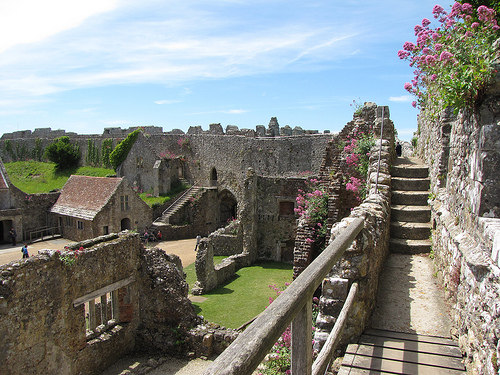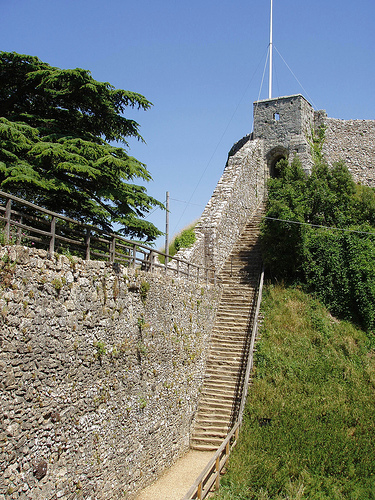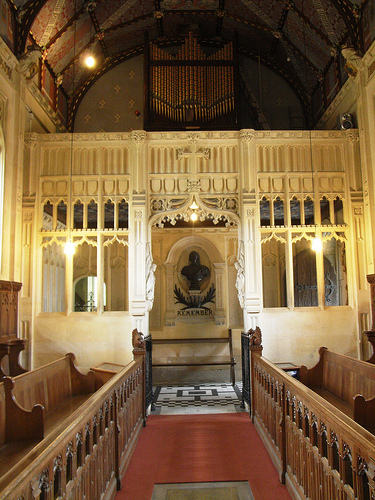

Location: Newport, Isle of WightMap
Constructed: 12th century
Tel.. 01983 522107
Entrance Fee:
Adult- £7.50, Child- £4.50, Family (2 adults, 3 children) £19.50
Open: Apr-Sept: 10am- 5pm
Oct- 4th Nov: 10am- 4pm
5th Nov- 17th
Feb: 10am- 4pm Sat, Sun
18th Feb- 24 Feb: 10am- 4pm
25th Feb- 28th
March: 10am- 4pm
Closed: 1 Jan, 24- 26 Dec
Carisbrooke Castle is a historic fortification located in Carisbrooke, near Newport, on the Isle of Wight. Carisbrooke is the only surviving medieval-era castle in Wight.
History
early times
The existence of settlements in the
place where the castle of Carisbrooke was built must already have
taken place in pre-Roman times. There are vestiges of a wall that
demonstrates its colonization in the last moments of the Roman
Empire. Subsequently, the Jutes must have taken over this primitive
construction at the end of the 7th century. An Anglo-Saxon
stronghold replaced the previous fortification during the 8th
century. Around the year 1000, a wall was built around the hill on
which the castle stands as a means of defense against Viking raids
on the island.
Norman invasion
Following the Norman
invasion of England, William the Conqueror ceded the Isle of Wight
to his friend William FitzOsbern, who commissioned the construction
of a wooden fortification at Carisbrooke. The castle, as such, is
already mentioned in the Alvington Domesday Book, so it must have
been built at the request of FitzOsbern himself, who was the first
lord of the Isle of Wight. From that time, the lordship of the
island was always linked to the ownership of the castle, which would
become the seat of government of Wight.
In 1100 Henry I
donated Carisbrooke to Richard de Redvers. The castle served as a
garrison under Baldwin de Redvers, 1st Earl of Devon, in support of
Empress Matilda in 1136, but was taken by Stephen of Blois.
later time
The castle remained in the possession of the Redvers
family until 1293, when Countess Isabella de Fortibus sold it to
Eduardo I. From that moment its government was entrusted to alcaides
as representatives of the crown, which would be its legitimate owner
from then on.
During the reign of Richard II, the castle was
unsuccessfully attacked by the French in 1377. Antonio Woodville,
Lord Scales and later Earl of Rivers, obtained royal grant to the
castle and lordship rights in 1467. It was Wydville who commissioned
the construction of the Woodville Gate, now called the Entrance
Gate.
Under the reign of Henry I, the castle's keep was
erected and in the time of Elizabeth I, to protect it from a
possible attack by the Spanish Armada, it was surrounded by an
elaborate pentagonal fortification designed by Sir George Carey.
King Charles I was imprisoned in the castle for fourteen months
before his execution in 1649. Shortly after his two youngest
children were also confined there, Princess Elizabeth of England
also died in this place in 1650. At the beginning of the century xx,
the castle was the residence of Princess Beatrice, daughter of Queen
Victoria, as Governor of the Isle of Wight (1896 - 1944). He is
currently in charge of English Heritage, a public body under the
Department of Culture of the British government.


Carisbrooke Castle was the most impregnable fortress on the island,
despite the fact that its location did not overlook the moors like
many other castles.
There are vestiges of a Roman fort under
the later buildings. Seventy-one steps lead to the keep from which a
magnificent view can be enjoyed. The area for domestic use is
located in the central enclosure of the castle, dating mostly from
the 13th century, with the upper floor dating from the 16th century.
Some are in ruins, but the main rooms are in a good state of
preservation, as they were used as the official residence of the
Governor of the Isle of Wight until the 1940s.
The Great
Hall, the Great Chamber and other smaller rooms are open to the
public. Also the top floor which houses the Isle of Wight Museum.
Most of the rooms are partially furnished, although they are
interesting in themselves thanks to their fireplaces and other
architectural details. Other attractions in the museum revolve
around the figure of Charles I of England and his captivity in the
castle, from which he tried to escape in 1648 but was unable to get
through the bars of his window.
Carisbrooke served to name
another very different structure in the antipodes of the United
Kingdom. A visit to the castle inspired James Macandrew, one of the
founders of the New Zealand city of Dunedin to name an estate
Carisbrooke. The name of this farm was later used to name the most
important sports stadium in Dunedin.
Front door
The castle
gatehouse with its turrets was erected by Lord Scales in 1464.
Chapel
The chapel is located next to the entrance door. In
1904, this chapel dedicated to Saint Nicholas was reopened and
reconsecrated, becoming a memorial to Carlos I. Under the wall is a
200-foot (60.96 m) deep well. There is also another one in the
center of the tower, which is believed to be even deeper.
well house
Near the noble area is the well house (Well-House)
dating from 1587 and with a curious structure of an animal and
wind-powered wheel to draw water. This is one of the castle's
biggest attractions, where long queues form to watch the Carisbrooke
donkeys work.
Constable's Chamber
Constable's Chamber or
Guard Chamber is a large room in the medieval area of the castle. It
served as a room for Carlos I during his stay as a prisoner in
Carisbrooke and as a dining room for Princess Beatriz. It is
currently used as the educational center of the castle for its
visitors.
pits
Surrounding the fortress there is a large
set of moats designed by the Italian engineer Federigo Giambelli,
which began to be built in 1587, a year before the Spanish Armada's
failed raid on England. They were completed at the end of the 1590s.
The outer portal, surmounted by the coat of arms of Elizabeth I of
England, contains the completion date of the fortified complex:
1598.
Lodging in Carisbrooke
English Heritage plans to
convert the former service premises into accommodation that can be
enjoyed by the visiting public of Carisbrooke. The administrative
permits have already been requested and its transformation of use
will take place during the year 2007.

